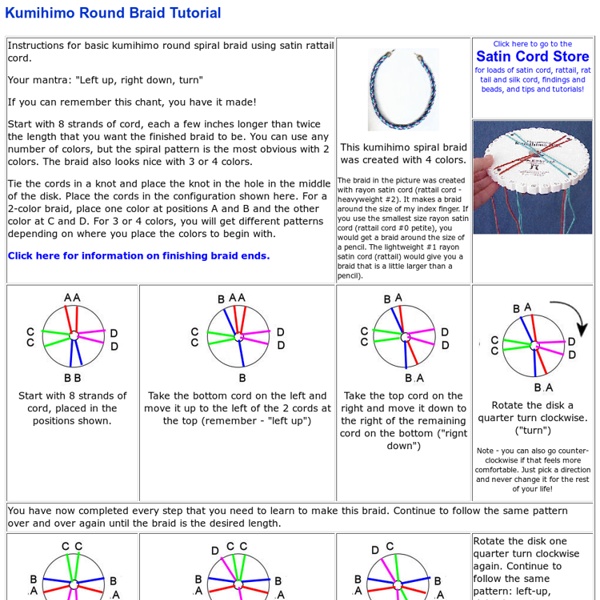



How to Make a Spiral Kumihimo Braid Instructions by Michelle Wood, Jewelry-Making Expert, Exclusively for Fire Mountain Gems and Beads® In this style of braid, the numbers change position as the disc is turned in a counter-clockwise direction. The kumihimo disk has 32 numbered slots and 4 dots indicating North, East, South and West. To determine strand length needed, multiply desired finished length by 3. Example: If you want a 20-inch necklace, you will need 60 inches of cord. Hold the folded cord end firmly in place on the underside of the disc while setting up the face of the disc. With North at the top of the disc, you are ready to start your braid.
How to Make Friendship Bracelets - in 7 Easy Steps Anyone can learn how to make friendship bracelets with beautiful intricate patterns. Let me show you how, with easy step by step instructions. Which design would you like to make? Even if you’re a complete beginner, you can make a pretty bracelet like one of these: It’ll probably take you an hour or so to make your first bracelet. There are some great books on making friendship bracelets, like the enormously popular Klutz Friendship Bracelet Book , but to make the bracelets on this page you won’t need to buy any books or special equipment. On this page, I’ll show you how to make friendship bracelets in 8 different designs. Friendship Bracelet Designs Here are all 8 friendship bracelet patterns: Hearts - great for Valentine’s Day Flowers Diamonds Rainbows Stripes - great for sports team colors Stripes and Dots Chevrons Checkered The trick is something called a braiding disc, or braiding loom. Ready to learn how to make friendship bracelets? How to Make Friendship Bracelets: Materials Step A:
Free Kumihimo Beading Pattern & Instructions Kumihimo, the ancient Japanese art of braiding, has wound its way into the hearts of beaders around the world. Beaded kumihimo is popping up in beaded jewelry designs using the newest beads and some very old braiding techniques. Some of the first kumihimo braids were made for soldiers who needed a way to secure saddles and gear to their horses, but these days, you’re more likely to see kumihimo with beads being used as handles for handbags, stunning necklaces made with gemstones, and fabulous beaded bracelets. Beaded kumihimo makes a wonderfully portable craft, once you’ve loaded your beads onto the threads placed on your kumihimo disk. Using a small, lightweight foam kumihimo disk means that you can take your kumihimo projects along with you wherever you go.
Gratuit : comment faire un disque pour bracelets Kumihimo ? Vous vous demandez ce qu’est le Kumihimo ? Littéralement, signifiant « tressage de cordon », il s’agit d’une nouvelle méthode pour créer des bracelets originaux, issus de l’art traditionnel de tressage japonais. Pour réaliser ces bracelets très tendances et notamment le modèle à 8 brins, il vous faut un mobidai (un disque). Fournitures Le gabarit du Mobidai pour Kumihimo Une feuille A4 de papier blanc 20 x 20 cm de carton plume ou de carton Un cutter de précision ou une paire des ciseaux Une planche à découper Comment faire ? Cliquez sur la miniature à gauche pour l’agrandir. Découpez votre disque et collez-le sur une planche de carton ou de carton plume, afin de renforcer votre disque. Retirez le disque de la planche de carton plume. Création : Julie Destouches A lire aussi :
Art Projects for Kids | Teacher-tested Art Projects I was looking for fun yarn projects to take to Haiti next month, and happily found this technique to make a rounded braid. It’s actually pretty simple to make, you may just have to help young ones get started. 1. Trace any cup to make a circle about 3.5″ wide. A little larger or smaller will work too. I used the back of a cereal box. 2. 3. 4. 5. 6. 7. 8. 9. 10. Pattern: Swarovski Christmas Beaded Round Kumihimo Braid This project works with an 8 warp round braid and beads. We have used a mix of light siam red and fern green Swarovski 4mm bicone beads. Use the following pattern information and work with our beaded kumihimo project to recreate this project on your own! fern green 4mm bicone Swarovski crystal beads on strands #32, #1, #16 and #17light siam red 4mm bicone Swarovski crystal beads on strands #8, #9, #24 and #25for a bracelet, we used 28 beads on each strand (this creates a 16.5cm beaded section - every extra bead added to a strand adds about 0.5cm to the beaded length)size #6 nylon cord works well with these beadssize #6 nylon cord produces a 2.2mm "plain braid", fits well into 2.7mm glue in leather endssee our beaded kumihimo project for basic instructions © 2015 www.eurekabeads.com.au These free beading instructions may be used for personal use only